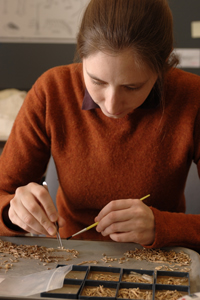Paleontologists add to fossil record, prize-winning record
By Steve KoppesNews Office
 Rebecca Terry, the recipient of the 2007 Alfred Sherwood Romer Prize from the Society of Vertebrate Paleontology, examines a fossil in the Hinds Laboratory. Photos by Dan Dry |
|
University paleontologists collect key prizes in their field year after year as if plucking fossils from an ongoing excavation.
Rebecca Terry, graduate student in Geophysical Sciences, carried off the 2007 Alfred Sherwood Romer Prize from the Society of Vertebrate Paleontology. Terry is the sixth University student to receive the Romer Prize since 1993. The Society of Vertebrate Paleontology awards the Romer Prize annually to a graduate student for outstanding Ph.D. research based on an oral presentation at the society’s annual meeting.
Also in October, alumnus John Alroy (Ph.D.’94) took home the 2007 Charles Schuchert Award of the Paleontological Society. Alroy, the 1994 Romer Prize recipient, became the first person to earn both prizes. Ten Chicago faculty members or alumni have received the Schuchert Award—the most of any university—since it was established in 1973. The prize is awarded annually to a scientist under 40 whose work reflects excellence and promise in paleontology.
Terry specializes in taphonomy, the study of how physical and biological processes determine the quality of the fossil record. She inventories small mammals—both living specimens and their skeletal remains—in Nevada and Utah to assess the impact of climate change and humans on ecosystems over centuries to millennia.
“I wanted to do paleontology that has direct relevance to conservation science,” Terry said. “The fossil record gives you a critical depth of time that you typically can’t get from modern ecological analyses, and I always felt that was really important.”
Rebecca’s father, Mark Terry, introduced her to paleontology and taphonomy. As a child, she would accompany her father, a high-school biology teacher at the Northwest School in Seattle, on annual field trips to Oregon’s John Day Fossil Beds. In her senior year, she got a formal taste of the science when she enrolled in his Primate Biology class.
Terry continued her scientific training at Macalester College in Minnesota, graduating in 2001 with a degree in geology. Her advisors at Macalester included Chicago alumnus Raymond Rogers (Ph.D.’95), himself a recipient of the Romer Prize (1993). Susan Kidwell, the William Rainey Harper Professor in Geophysical Sciences and the College, and the 1995 Schuchert Award winner, was Rogers’ Ph.D. adviser and now advises Terry in her Ph.D. work.
 | |
Kidwell mainly studies living and dead clams and snails to establish the quality of the fossil record in coastal and open-marine settings. She has found that the dead shells that accumulate in marine sediments can accurately capture important ecological information from past times, including the ways in which humans have recently disturbed the ecosystem.
Terry’s Ph.D. research is the first live-dead study of small mammals. She is establishing what types of small mammals have lived recently in the Great Basin of Nevada and Utah by her own trapping surveys and by consulting a century’s worth of trapping records from museum collections. She is extending that record back 13,000 years in Utah, and 10,000 years in Nevada by analyzing the skeletal remains of small mammals found in owl pellets, which accumulate in caves over millennia.
“The amount of agreement that I’m getting between living communities and the skeletal remains that are left behind is basically the same as Sue gets in her marine system,” Terry said, referring to Kidwell. “These are totally different systems, and yet you’re getting the same high quality of information captured by their fossil records.”
When Terry made her prize-winning presentation at the Society of Vertebrate Paleontology meeting and received her award, her father was on hand. “That made it extra special,” she said.
John Alroy had trod the halls of Hinds Laboratory as a graduate student, just as Terry does today. Alroy is coordinator of the Paleobiology Database at the National Center for Ecological Analysis and Synthesis, at the University of California, Santa Barbara. He co-founded the database along with 1999 Schuchert award recipient and Chicago alumnus Charles Marshall (Ph.D.’89), a Professor in Biology and Geology at Harvard University.
“There’s no question that this is a very important thing for the field,” said 1988 Schuchert Award winner David Jablonski, the William Kenan Jr. Professor in Geophysical Sciences and the College. “The data of paleontology are so scattered and so diverse, pulling that together is a huge service for the entire community and will allow us to ask all kinds of new questions.”
Contributors to the Paleobiology Database, including many Chicago faculty and alumni, scour paleontological publications to compile lists of all species that occur at a given locality in a given interval of time. The result is a database of unprecedented scope and detail, enabling large-scale analyses of the history of fossil diversity as never before.
“John has also made a wide range of contributions on the dynamics of mammal diversity since they exploded after the demise of the dinosaurs 65 million years ago,” said Jablonski. “He’s much more than just a database guy.”
![[Chronicle]](/images/sidebar_header_oct06.gif)